Two Fish Divers, Lembongan; Alam Batu, Bali, IndonesiaContents of this Issue: Two Fish Divers, Lembongan; Alam Batu, Bali, Indonesia An Investment for the Gullible When Dive Gear Evidence Goes Missing Belize, Little Cayman, the Conflict Islands American Underwater Photography Team Cleans Up Again When Your Cabin Mate Gets Sick The Conception had been Exempted from USCG Fire Safety Standards The Ticking Time Bomb of War Wrecks The Best Travelerís Diarrhea Drug A Template for Liveaboard Safety Precautions The Ins and Outs of Trip Insurance Lawsuit over Crown-of-Thorns Starfish Sting A Chance to Get Shark Bytes at Half Price Diving and Politeness: Be Patient and Take Your Place in Line Editorial Office: Ben Davison Publisher and Editor Undercurrent 3020 Bridgeway, Suite 102 Sausalito, CA 94965 two destinations, one for reefs, one for muck from the February, 2020 issue of Undercurrent
For many divers traveling to Indonesia, Bali is a stopover en route to a primary destination, allowing a few days to blow off the fog of jet lag and get a few warm-up dives. For others, it's a diving destination in an exotic culture, with time spent touring the countryside and enjoying the crafts of Ubud. Either way, there's plenty of good diving, and this month, we're running shorter reviews of two destinations that can serve either as a stopover or a primary destination. * * * * * * * mantas and molas and mantis shrimp, oh my!Dear Fellow Diver,
On my first two dives -- Toyopake and PED -- I kicked down 75 feet, to sloping reefs with huge mounds of staghorn coral, multi-colored sponges, brittle stars and clownfish nests, to enter a busy intersection with spadefish, jacks, fairy basslets, tangs, Moorish idols, bannerfish, and bandit butterflyfish rushing in every direction. Visibility was 75 feet on both dives, but so was a one-to-two knot current, a norm in these parts. So I left my big-rig camera in my room, a wise choice. My buddy, a retired Englishman, had carried his, but the current didn't let him snap one shot. I was there during the first half of November, the lowest of the low season (and the end of mola mola season), so I roasted in mid-day humidity during the 82- to 90-degree afternoons; mornings and evenings weren't much cooler. The upside was fewer divers on the boat: only four the first day -- two 60-ish Swedish women, the retired Brit, and me. Two exuberant Luxembourgers who were getting their divemaster certifications came along to practice their rescue exercises while we drifted the technicolor coral gardens. I know Bali well, but I had never been to Nusa Lembongan, an island off the southeastern coast. I chose Two Fish because of the great experiences I have had at both its Lembeh and Bunaken resorts. A 45-minute van ride from the Denpasar airport to the "Rocky Fast Boat" and a 45- minute fast bumpy crossing to Lembongan Island led to the final transit to the resort, a 15-minute ride on bench seats in a swaying openback van. Ten rooms surround a pleasant little courtyard, with a pool and bar at one end, a tilefloored dining area at the other, and a 200-meter walk to the boats. At the beachfront dive shop, Valeri, the Ukranian dive manager, gave me a thorough briefing, explaining they planned dive times around the tides and wave forecasts -- the huge swings in daily tides sometimes made it impossible for the boats to get out. We were twice delayed 30 minutes to let the tide rise. During peak season, Two Fish has a maximum of four divers per guide; my buddy and I joined Frankie, a silent type in his early 30s who, as it turned out, I dived with at Two Fish Bunaken 10 years ago; he even remembered a dive where I had a sea urchin stuck to my knee pad. While not chatty, Frankie kept a hawk's eye on us underwater, occasionally signaling to change directions to avoid the downcurrents that are common here. The other two dive guides were young Indonesian women -- one a former waitress trained at Two Fish, the other a fully covered Muslim woman (no veil, obviously), who always wore a dive hood. They all catered to divers' objectives. Given my 1,000- dives experience, I was told no checkout dive was required. Staff always carried my dive gear to the boat, so all I had to handle was my dry bag and a towel. There were typically no afternoon dives because of low tides, and only mediocre night diving, which they skipped for advanced divers. So, it's really a two-tank-a-day destination. But the morning dives mostly were enough for me, especially when I spotted a mola mola -- about 6 feet high -- on my second day, cruising along at Sental, a sloping reef at 100 feet. Watching the oblong, ivory creature waving its dorsal and caudal fins in synch filled me with calm. The slow drift dive let me snap pictures of a sweetlips, reticulated butterflyfish, Clarkii clownfish and a giant puffer. Alas, no way in the two-knot current could I capture little stuff like nudibranchs. With no camera room at this Two Fish resort, a dunk tank at the back of the resort mingled cameras and computers. Luckily, my room had plenty of outlets and a long table for my camera gear.
But, the lunches at Two Fish took the smile off my face, though I was in the minority. As a low-carb carnivore, the buffet of noodles, rice, noodles and rice with vegetables (or sandwiches), and fruit salad didn't work for me. My option was chicken satay and veggies smothered in sweet peanut sauce. So, I walked five minutes to one of many good, cheap places with lots of options for carnivores, vegetarians and vegans. I did the same for dinner, where the typical price ran US$5 to $7. Resort breakfasts were standard fare -- the Balinese dish of nasi goreng (eggs with rice and veggies), eggs to order, bacon (a few pennies extra), toast, fruit, chocolate cereal, and pancakes, if you asked. After dinner, I joined the other divers, mostly from Europe, to sit around the pool bar and shoot the breeze under the stars. Two expat instructors from Estonia and New Zealand who once worked for Two Fish regularly returned to hang out and chat, and some of the local guides joined in.
One day, the tides and waves allowed us to motor to Manta Point. Their newish, fiberglass boat officially holds up to 12 divers, but the eight of us were plenty. We were the first of 20 boats to arrive. Within a few minutes after backrolling, a few giant mantas began circling around us in the 30-foot visibility, five in close. After they vanished, Frankie took us to another area in search of mantas, but only one appeared. Wearing my custom 5-mil wetsuit with a hooded fleece vest underneath, I was comfortable enough in the water temperatures averaging low- to mid-60s here and at Manta Bay and Crystal Bay - everywhere else in was 80-82F. Then off to Crystal Bay on such a rough ride that I wrenched my back when we came crashing down on troughs of ocean waves. I decided to sit out the dive, and missed nothing, since no mantas appeared. Such is the luck in diving. My luck turned again during a 6:30 a.m. sunrise dive at Crystal Bay. I was at 30 feet when the pee-break-diver spotted a mola mola 60 feet away. I hightailed it to within 20 feet of the big mama and started clicking. She came closer and closer, then turned to show me her fantastic profile before heading out to sea.
Even for experienced divers, Lembongan's currents and tides can be challenging. And the lack of afternoon dives is sometimes frustrating. But the rich marine life, especially if you get up close to the mantas and mola molas, is worth it for divers who prefer a leisurely pace. -- D.S. Our undercover diver's bio: "I got the diving bug watching Sea Hunt as a kid, got certified in 1983, but didn't start diving the world until 1991. I've logged more than 1,200 dives in the Caribbean, Indonesia, Australia, Tahiti, Palau, PNG, Maldives and the Philippines . While I love the convenience of liveaboards, I also enjoy resorts for their relaxing pace and beauty . My life goal is to dive on my 90th birthday. (Only 22 years to go!)"
* * * treasures among the muck at a great priceDear Fellow Diver, I backrolled off the rigid hull inflatable boat on my first Bali dive at Alam Batu, expecting the usual muck bottom: junk like beer bottles, tires, and cans in low-visibility water. But I was pleasantly surprised. During my 12 days' diving in September, I never saw a beer bottle or other junk in the 30- to 50-foot-visibility. The few times I did see coral, it was in good shape. I did find that macro life is not as plentiful as in Lembeh and the Philippines. And even though Alam Batu's guides are knowledgeable and helpful, a couple of times it took a good 10 minutes for Dolfi and Patu, local guys in their mid-20s, to find something worthwhile to shoot. With a little patience, however, I found ample subjects to excite even the most experienced macro photographer: varied nudibranchs, rhinopias, colorful cleaner shrimp, and pipefish of all sizes. The "sexy" shrimp was fun to watch as it visibly lifted its butt and then wiggled as it walked. There were enough frogfish for everyone to shoot at least one; unlike their Caribbean cousins that blend into the sponges they perch on, these sit on the mucky bottom, making them easier to spot.
The lovely resort, on a rocky black-sand beach, is lush with well-tended tropical plants, and features 12 bungalows and three villas with thatched roofs surrounding an infinity pool. The dim nighttime lighting may be good for putting couples in a romantic mood, but for this old guy (but I'm not a fuddy duddy) I'm just glad that my room came with a flashlight -- I needed it for walking along the slate walkways to the main building for dinner. My room came with a small fridge stocked with soft drinks and Bintang, the excellent local beer. My canopy bed was comfortable, and I never had a problem with bugs. The AC was adjustable and more than adequate, and the free Wi-Fi worked great. The indoor/outdoor bathroom was unique -- the sink and toilet were under a roof while the shower was open-air, albeit surrounded by seven-foot walls. I had plenty of hot water and pressure for my showers. When I had an electrical problem, Danny, the general manager from Switzerland, was quick to have it fixed. Alam Batu's guides were hands-off on dive profiles: no checkout dives and no restrictions, so I could dive any profile I wanted. However, the gently sloping mucky bottom made it easy to go into deco. Most dives were in the 60-foot range, but on one down to 80 feet, I spotted a half-inch pygmy seahorse whose coloration matched the soft coral it sat on. Up at 50 feet, I came across spotted damselfish, anemonefish, octopus, jacks, barracuda, ribbon eels, convict fish, schooling glassfish, emperor angelfish and a few stingrays. The 78-degree water meant I wore my 5-mm wetsuit, but others were fine with a 3-mm vest. The rigid hull inflatables (RHIB) were smallish, measuring 25 feet and carrying just eight divers, but sitting on the gunwales was easy traveling as the hulls cut a smooth ride through the usual chop. Also, nearly all dive sites were less than five minutes, the longest 15 minutes to the 412-foot U.S.A.T. Liberty, torpedoed in 1942 and moved 200 yards off the beach by a large volcanic eruption two decades later. She sits at a depth of 30-100 feet. I got some good wide-angle shots of a few sponges in 50-foot visibility, but the ship is not encrusted.
In the open-air gear area, each of us had our own roomy spot for hanging wetsuits, booties and regulators, and mesh bag, and mesh shelves allowed for quick drying of masks and computers. The pleasant breeze dried my wetsuit in just five hours. Staffers in the tank room filled my tanks, then placed them with BC attached on a rack in the center of the room, where I checked pressure and oxygen levels before they carried them to boats. I never lifted a tank during my stay. The guides placed my camera in one of the two dunk tanks, where I never saw anything but clean water. Two non-air-conditioned camera rooms sat next to the gear area, where I had generous space with shelves and plenty of 220-volt sockets. While there is no dive shop, there is rental gear in great condition. The resort's luxurious spa is surrounded by lush flora, with a small walkway that traverses a coy pond. The massages -- about $28 -- are offered in open-air massage huts so one can hear the waves hitting the beach. I passed, but others said the massage therapists were first-rate by European standards. Given how the guests were so truly international (American, Europeans, Chinese and Americans), the spa recommendations carried much weight.
When you have traveled this far, spend a few hours in the town of Ubud, which is between the resort and Denpasar. It's a mecca of Balinese art and culture, built along a steep valley with typically Balinese terraced rice paddies, a lovely sight to behold. Many shops sell hand-carved wood art, which the Balinese do very well and are by no means typical tourist knick-knacks. You'll also discover interesting pieces of glass art and original hand-carved furniture in teak and other indigenous woods. For adventurous foodies, Bali produces the world's most expensive coffee, Luwak, which is over $300 per pound. A single, small cup costs about US$10. What makes this coffee so pricey is that -- CAUTION: gross alert -- it's made from beans ingested by a Balinese civet and then pooped out! One presumes that the beans are fully cleaned before roasting and grinding. One maddening thing is the exchange rate of the Indonesian rupiah, for the US dollar: 1 USD equals 13,890 rupiah, which I was hopelessly unable to calculate in my head. For a bit of luxury and great prices, excellent diving for any level, and plenty to do for nondivers, Alam Batu is just the ticket. -- J.D.F. Our undercover diver's bio: J.D.F. was certified in 1980 and is a PADI Advanced Open Water diver with over 900 dives, both shore-based and liveaboard, in the Caribbean as well as Indonesia and the Philippines. For the past seven year,s he's pursued underwater photography; macro is his favorite.
|

I want to get all the stories! Tell me how I can become an Undercurrent Online Member and get online access to all the articles of Undercurrent as well as thousands of first hand reports on dive operations world-wide
| Home | Online Members Area | My Account |
Login
|
Join
|
| Travel Index |
Dive Resort & Liveaboard Reviews
|
Featured Reports
|
Recent
Issues
|
Back Issues
|
|
Dive Gear
Index
|
Health/Safety Index
|
Environment & Misc.
Index
|
Seasonal Planner
|
Blogs
|
Free Articles
|
Book Picks
|
News
|
|
Special Offers
|
RSS
|
FAQ
|
About Us
|
Contact Us
|
Links
|
3020 Bridgeway, Ste 102, Sausalito, Ca 94965
All rights reserved.

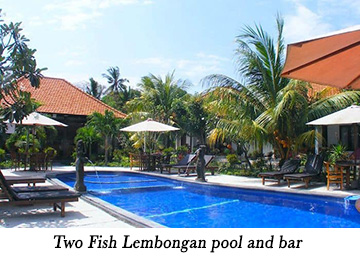 Think Cozumel drift diving, only with five times the coral and fish life. Add mola molas, the giant oceanic sunfish. And giant mantas, too. And you've got it.
Think Cozumel drift diving, only with five times the coral and fish life. Add mola molas, the giant oceanic sunfish. And giant mantas, too. And you've got it.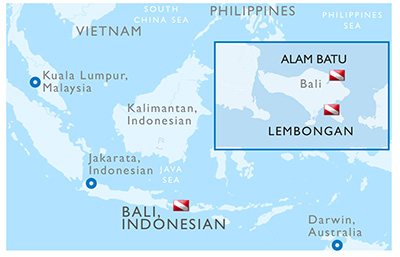 My dive at Mangrove was a roller-coaster dive at three-knot speed, like zipping through an aquarium above expansive, 50-foot-wide fields of staghorn. It was a great 35-minute ride with 100-foot visibility. My buddy, guide and I always surfaced together, with Frankie's safety sausage inflated, never waiting long for a pickup. For our surface interval, we tied up to a buoy in an area with a ripping current. A new diver who needed a bathroom break jumped over the side but missed grabbing the boat line, and within seconds he was swept 100 meters away. The crew quickly untied and picked him up, and while he looked a little sheepish, he returned smiling.
My dive at Mangrove was a roller-coaster dive at three-knot speed, like zipping through an aquarium above expansive, 50-foot-wide fields of staghorn. It was a great 35-minute ride with 100-foot visibility. My buddy, guide and I always surfaced together, with Frankie's safety sausage inflated, never waiting long for a pickup. For our surface interval, we tied up to a buoy in an area with a ripping current. A new diver who needed a bathroom break jumped over the side but missed grabbing the boat line, and within seconds he was swept 100 meters away. The crew quickly untied and picked him up, and while he looked a little sheepish, he returned smiling.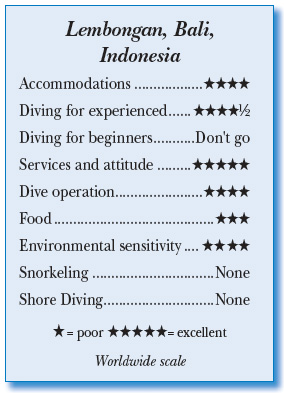 Some afternoons were scorchers, making me long for an afternoon dive, but there was lots to explore by scooter or motorbike -- cliffs, caves, and day resorts with calm beaches good for snorkeling -- especially on the neighboring island of Nusa Penida, connected by a bridge. Seen as the Bali of old, it's popular with tourists. Some days, I just returned to my spacious room to read and nap. I had steady A/C, a comfortable bed (they have kings and doubles), a shaded porch with beanbag chairs, big front windows and a shower with plenty of hot water, albeit not a gushing flow. Bugs were never an issue, although dengue fever has increased in Bali, so it might make sense to lather up in the morning since dengue mosquitoes are day biters.
Some afternoons were scorchers, making me long for an afternoon dive, but there was lots to explore by scooter or motorbike -- cliffs, caves, and day resorts with calm beaches good for snorkeling -- especially on the neighboring island of Nusa Penida, connected by a bridge. Seen as the Bali of old, it's popular with tourists. Some days, I just returned to my spacious room to read and nap. I had steady A/C, a comfortable bed (they have kings and doubles), a shaded porch with beanbag chairs, big front windows and a shower with plenty of hot water, albeit not a gushing flow. Bugs were never an issue, although dengue fever has increased in Bali, so it might make sense to lather up in the morning since dengue mosquitoes are day biters.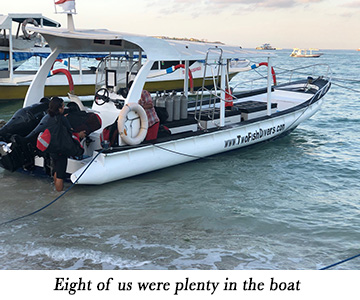 On my last dive day, I requested a dive to shoot macro. I chose the right day -- no currents at either site. At the lush reef of Toyapakeh, I found multiple anemone nests, hordes of fish swarms, eels, sea snakes, giant puffers, scorpionfish, lionfish and gobies. At Crystal Bay, I got shots of 10 different nudibranchs, two octopuses, a flying gurnard, an orangutan crab, and a giant gray frogfish free-swimming, then loping, across the bottom. Lots of dive boats joined us, but I managed to steer clear of their occupants, and Frankie helped me find many subjects. Later, looking at my photos of a whacking mantis shrimp and seeing the fine details of its "face" made me happy that I had come to this new-to-me Balinese island.
On my last dive day, I requested a dive to shoot macro. I chose the right day -- no currents at either site. At the lush reef of Toyapakeh, I found multiple anemone nests, hordes of fish swarms, eels, sea snakes, giant puffers, scorpionfish, lionfish and gobies. At Crystal Bay, I got shots of 10 different nudibranchs, two octopuses, a flying gurnard, an orangutan crab, and a giant gray frogfish free-swimming, then loping, across the bottom. Lots of dive boats joined us, but I managed to steer clear of their occupants, and Frankie helped me find many subjects. Later, looking at my photos of a whacking mantis shrimp and seeing the fine details of its "face" made me happy that I had come to this new-to-me Balinese island. Divers Compass: I paid $1,300 for a 10-day stay, 20 dives, breakfasts and lunches, and a couple of small fuel surcharges . . . Beer and limited mixed drinks at the resort bar were cheap, but wine wasn't available . . . The dive shop has rental equipment but no nitrox . . . . Fairs for the 24-plus-hour trek to Bali were cheap (I've paid more to go to the Caribbean) . . . Best season is between August and October for better chances of mola mola sightings . . . Bali has two recompression chambers . . . Website:
Divers Compass: I paid $1,300 for a 10-day stay, 20 dives, breakfasts and lunches, and a couple of small fuel surcharges . . . Beer and limited mixed drinks at the resort bar were cheap, but wine wasn't available . . . The dive shop has rental equipment but no nitrox . . . . Fairs for the 24-plus-hour trek to Bali were cheap (I've paid more to go to the Caribbean) . . . Best season is between August and October for better chances of mola mola sightings . . . Bali has two recompression chambers . . . Website: 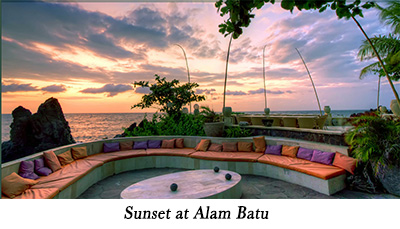 Once landing at Denpasar Airport, Alam Batu, which is northwest of Tulamben, is easily reached via the hotel shuttle van that picks up guests and their gear for the 53-mile, 2.5-hour journey to the resort (Bali's traffic is notorious). But, it's an enjoyable ride, past steep hills, narrow valleys with healthy vegetation, small villages and busy people.
Once landing at Denpasar Airport, Alam Batu, which is northwest of Tulamben, is easily reached via the hotel shuttle van that picks up guests and their gear for the 53-mile, 2.5-hour journey to the resort (Bali's traffic is notorious). But, it's an enjoyable ride, past steep hills, narrow valleys with healthy vegetation, small villages and busy people.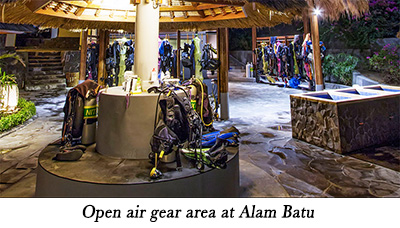 The RHIB's steady ladders were easy to climb after removing my gear in the water and handing it to a hovering guide. We took surface intervals back at the resort, where they served
tasty snacks like coconut
muffins. But the downside
was getting onto the boats,
which are moored 30 yards
out: one has to walk out on a
rocky beach and through surf,
then swim to them, which
was not a problem after the
initial surprise. The divemasters
swam out the cameras
and scuba gear, which didn't
faze them because they're
in good shape. Indeed, the
dive leader, Yustus, was so
strong that he carried my 65-pound Pelican case like a briefcase.
The RHIB's steady ladders were easy to climb after removing my gear in the water and handing it to a hovering guide. We took surface intervals back at the resort, where they served
tasty snacks like coconut
muffins. But the downside
was getting onto the boats,
which are moored 30 yards
out: one has to walk out on a
rocky beach and through surf,
then swim to them, which
was not a problem after the
initial surprise. The divemasters
swam out the cameras
and scuba gear, which didn't
faze them because they're
in good shape. Indeed, the
dive leader, Yustus, was so
strong that he carried my 65-pound Pelican case like a briefcase.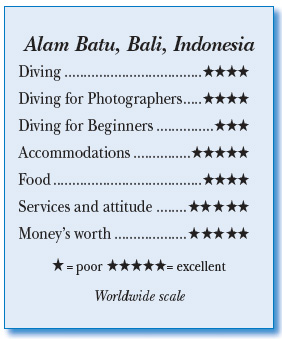 The open-air dining room, built on the edge of
the ocean, sports a gentle sea breeze, and guests
dine at several round community tables, at which
helpful and smiling Balinese women in traditional dress serve breakfast and lunch.
Dinners, a combination of Western and Balinese foods, offer a choice of fish, beef
and pork, with chicken often served. Breakfast is served in the dining room and
includes eggs, bacon, pancakes, and other typical breakfast fare. Breads, which
are baked daily, are served warm from the oven at breakfast. At breakfast, guests
select lunch from a menu, which includes sandwiches, soups and salads plus hot
entrees, including excellent pizza. Indeed, if for any reason you don't like the
food in the dinner buffet, just ask and the kitchen will happily prepare anything
from the lunch menu. There is no bar per se at Alam Batu, but you need only ask a
server for beer or spirits and they'll happily bring it for an extra charge.
The open-air dining room, built on the edge of
the ocean, sports a gentle sea breeze, and guests
dine at several round community tables, at which
helpful and smiling Balinese women in traditional dress serve breakfast and lunch.
Dinners, a combination of Western and Balinese foods, offer a choice of fish, beef
and pork, with chicken often served. Breakfast is served in the dining room and
includes eggs, bacon, pancakes, and other typical breakfast fare. Breads, which
are baked daily, are served warm from the oven at breakfast. At breakfast, guests
select lunch from a menu, which includes sandwiches, soups and salads plus hot
entrees, including excellent pizza. Indeed, if for any reason you don't like the
food in the dinner buffet, just ask and the kitchen will happily prepare anything
from the lunch menu. There is no bar per se at Alam Batu, but you need only ask a
server for beer or spirits and they'll happily bring it for an extra charge.